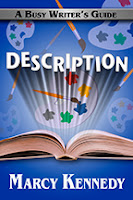Part of the Indie Author Series
As independent authors, we’re in charge of everything, including marketing our books. There are a lot of ways to spread the word, but today I’m starting into a mini-series on advertising for indie authors.
I think this is an important topic for us to understand because it can either help our sales or lose us a lot of money. The more we know, the better our chances are of making money off our ads.
In other industries, marketing departments will sometimes run ads without worrying about whether or not the ads earn them more than what they spent on it. Their purpose in running the ads is brand awareness more than sales. Most authors want to see an increase in sales and a positive return on investment (ROI) from their ads, so that’s the perspective I’m approaching this post from. (I’ll look at when it’s okay to lose money on ads in another post.)
(Here's more on Understanding Pay-Per Advertising)
To start, let’s cover some of the basics.
When Should We Advertise?
I’m not talking about time of the day or day of the week or even whether ROI is better in summer vs. winter or over the holiday season. If you love data crunching, those are things you can experiment with.
What’s more important, in my opinion, is when it’s best to advertise from a career perspective. Because, if you jump in too early, you can do everything right and still lose money.
Advertising works best when we have at least three books out. The reason is read-through. You might not technically break even or earn a positive return on your investment on sales of the advertised book, but if those buyers go on to read your other work, you not only have a new fan, but you’ll easily earn back more than you’ve spent.
(Here's more on Understanding Newsletter Ads)
What Should We Advertise?
I know this might seem like a no-brainer—we should advertise our books, right?—but not all books are created equal.
The best books to advertise are the first in series or a box set.
First in Series
In a traditional series where each book builds on the previous book, most readers won’t be interested in jumping into our series on the second, third, or eighth book. Nor do we really want them to. This means that advertising the later books in a series usually loses money.
If our series is loosely connected (e.g., romances with separate couples in a shared world), then we can technically advertise any book in the series we want. If we’re advertising full-priced books, that can be a good strategy because, while one book’s concept might not catch a particular reader, another book’s concept might. If we’re advertising discounted books, though, I personally recommend picking a single book in the series and only discounting it. Otherwise, you risk training readers to wait for the sales rather than buying your books at full price.
Box Sets
Once we have enough books in our series, one of the best things we can do is to bundle them into a box set. (If you’re new to box sets/bundles, I recommend you read my posts on creating box sets Part One and Part Two.)
Because box sets have a higher selling price, it’s easier to have a positive ROI on any full-priced advertising we run. If we’re running a sale ad on a box set, we also have an increased likelihood of hooking the reader on our series. Readers won’t have to make separate purchases for each book, making them more likely to read all the books in the set and investing them in the series so they want to continue on past the box set to see what happens.
(Here's more on Are Your Book’s Ads Earning or Losing You Money?)
How Should We Advertise?
The how is about whether we’re advertising a full-priced, discounted, or free book.
Our business strategy will influence this a lot. (Not sure what I mean by business strategy? Check out Jami Gold’s series of posts on Indie Publishing Paths.) There isn’t a right or a wrong here. What’s important is knowing our goals and being intentional about what we’re doing.
Some advertising methods require us to have a free or discounted book in order to use their service (e.g., most newsletter services). The focus in this type of advertising isn’t earning our money back from sales of the advertised book. It’s on capturing new readers who will hopefully go on to read the rest of our books and return our advertising investment to us that way.
Other advertising methods (e.g., Facebook ads and other pay-per-click options) work much better when we have a full-priced product. The higher the price, the better in fact because we’re looking to have a positive return on investment from sales on the advertised product. Box sets are ideal for this type of advertising.
(Here's more on Author Advertising: Stacking Ads to Maximize Promotional Dollars?)
Who Should We Advertise With?
Stay tuned. I’ll be talking more about newsletter services, pay-per-click ads, and other ad permutations in upcoming posts!
So there’s our overview. If you’re feeling overwhelmed, don’t worry. This was a high-level look at advertising. In the coming months, we’ll look at a lot of this in more detail so that you can feel more confident about deciding whether advertising is the right choice for your career and what type of advertising you want to do.
Have you tried advertising your books? What are your biggest questions, concerns, or fears when it comes to advertising?
 Marcy Kennedy is a mystery and speculative fiction writer who believes fantasy is more real than you think. Alongside her own writing, Marcy works as a freelance fiction editor and teaches classes on craft and social media. She’s also the author of the Busy Writer’s Guides series of books. You can find her blogging about writing and about the place where real life meets science fiction, fantasy, and myth at marcykennedy.com.
Marcy Kennedy is a mystery and speculative fiction writer who believes fantasy is more real than you think. Alongside her own writing, Marcy works as a freelance fiction editor and teaches classes on craft and social media. She’s also the author of the Busy Writer’s Guides series of books. You can find her blogging about writing and about the place where real life meets science fiction, fantasy, and myth at marcykennedy.com. Blog | Facebook | Twitter | Amazon | Apple iBooks | Barnes & Noble
About Description
 Description in fiction shouldn’t be boring for the reader or for the writer.
Description in fiction shouldn’t be boring for the reader or for the writer. Description: A Busy Writer’s Guide will help you take your writing to the next level by exchanging ho-hum description for description that’s compelling and will bring your story to life, regardless of the genre you write.
In Description: A Busy Writer’s Guide, you will
- find the answer to the age-old question of how much description is too much;
- learn how to use point of view to keep description fresh;
- recognize the red flags for boring description in fiction;
- explore how to use all five senses to bring your descriptions to life for the reader;
- discover the ways metaphors and similes can add power to your descriptive writing;
- gain the tools needed to describe setting, characters, and action in engaging ways;
- learn how descriptions can add conflict, enhance the theme, and amp up emotion; and
- much more.


This is going to be an exciting series! I started publishing about a year and a half ago and have learned some advertising lessons through trial and error, but I'm really curious to find out what you know. Thanks for doing this!
ReplyDeleteThanks.
ReplyDeleteI never thought about it, but I can see the logic of not spending a lot of ad time or money on subsequent books in a series. The only question I have about that is, then, how to draw attention to the fact that those books exist. Otherwise, I can see the value of keeping the spotlight on the first book. Thanks for the food for thought!
ReplyDeleteKnowing next to nothing about advertising, I'm glad I've come across your clear and no nonsense post. =)
ReplyDeleteHere's a related question: When I try to get a review for a book in a series, reviewers come back at me saying something to the effect that they don't like to review them. Sometimes I win the battle by responding that all my books are independent stories. One reviewer told me once that I should teach a course on how to do that, because I do it well. Most of the time, they don't budge.
ReplyDeleteI'm sure something similar occurs for advertising. My conclusion: today's concept about what a series is has become distorted. All it means is that the author is using some of the same characters again. A series should never be a soap opera! In particular, when I review a book with a cliffhanger (a la soap operas), I slam the book in my review!
r/Steve